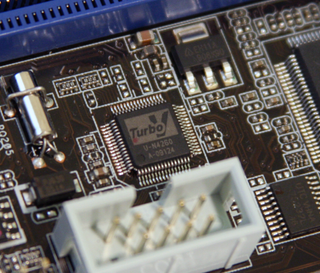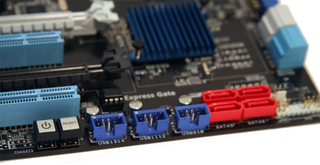Asus' P7P55D EVO Motherboard: Core i5 Finds A Home
Go Go Gadget, TurboV

The P7P55D Evo sees the return of Asus' TurboV functionality, which enables real-time manipulation of overclocking settings, including clock multipliers, frequencies, and voltages from within Windows. Asus claims that the version currently on our engineering sample isn't final. Rather, the shipping P7P55D Evo will sport what the company calls its next-gen TurboV utility.
A Silk-Screened Name

Right above the P7P55D Evo's name tag is the first PCI Express x16 slot, which employs all 16 of the Core i5's integrated lanes when you drop a single graphics cards onto the board. Three slots down is the second x16 slot, which breaks into x8 signaling when you drop in another card. The ICs between the two slots are responsible for automatically dividing available PCI Express connectivity between them when you use a pair of graphics cards.
EPU, Back Again

The board includes Asus' second-generation EPU technology. While we've looked at this technology in the past, finding it largely ineffective on the energy-efficient platforms most likely to enable it, we'll be curious to see how its behavior changes when paired to a Core i5 processor, which is architecturally very different from the Core 2 Duo tested previously.
Ports, Headers, And Buttons

In its current trim, the P7P55D Evo boasts eight SATA ports: six 3 Gb/s connectors derived from the P55 PCH and two stemming from Marvell's 6 Gb/s controller. Naturally, the two Marvell-based ports are currently disabled, but the P55's connectors work fine. As with Intel's ICH10R, P55 includes Intel Matrix Storage technology with software support for RAD 0, 1, 5, and 10. According to Intel, a new user interface will accompany this release of Matrix Storage software.
Access to the chipset's remaining USB and FireWire ports comes through headers at the bottom of the board, which you can either attach to front-panel connectors or rear-accessible breakout cables.
Of course, the convenient power and reset buttons we've grown accustomed to are down there, as well (not necessarily in the most convenient place, but for an open-air test bench, they work fine).
One Last Look

The board, once again. We're looking forward to testing this and other P55-based designs before Intel actually launches its Core i5 processor a little later this year. When the time comes, you can be sure we'll have comprehensive coverage. In the meantime, we'll continue previewing boards/compatible coolers as they arrive in our lab.
Stay on the Cutting Edge
Join the experts who read Tom's Hardware for the inside track on enthusiast PC tech news — and have for over 25 years. We'll send breaking news and in-depth reviews of CPUs, GPUs, AI, maker hardware and more straight to your inbox.
-
burnley14 I'm still a little curious why Intel released 2 new sockets so close together. I'm sure there has to be a good reason why i5 was not released on 1366, since it certainly makes things less convenient.Reply -
cangelini burnley14I'm still a little curious why Intel released 2 new sockets so close together. I'm sure there has to be a good reason why i5 was not released on 1366, since it certainly makes things less convenient.Reply
Think of i7 as Xeon 5500-series and it makes a little more sense. That was Intel's high-performance breakout of what it was planning in the workstation/server market, really. -
anamaniac I love you Angelini.Reply
I want a i5 now. =D
The board is very clean looking. Hope they keep up the perfect professional look (such as the 15 phase power, which looks very sexy all neatly organized, and the colour scheme). -
doomtomb Thank you for this look over on the board. It appears as though the P55 boards have plenty of features but lack in the PCI-Express department which is rather disappointing for even people looking at two-way SLI or Crossfire (like myself).Reply -
dmv915 falchardWhere is the southbridge?Reply
That basically is the south bridge that you see. P55 is a single chip motherboard. Most if not all of the north bridge has been moved onto the cpu. -
Losing one memory channel isn't too bad, benchmarks show Nehalem gets enough bandwidth from dual channel. But it's disappointing to think that most P55 boards will have only 4 dimms. I was waiting for i5 to build a workstation running SQL Server and wanted to put at least 12 GB of RAM inside (2GB DDR3 sticks are a lot cheaper than 4GB sticks).Reply
-
cimtaurus doomtombThank you for this look over on the board. It appears as though the P55 boards have plenty of features but lack in the PCI-Express department which is rather disappointing for even people looking at two-way SLI or Crossfire (like myself).This was exactly my reasoning for NOT waiting for the i5 and instead building an i7 machine.Reply
When the new 40nm cards come out I want to put triple SLI into my rig, and i5 just wouldn't handle that well.
Still, for a mid range machine this looks promising. If/when they develop some micro boards for the i5 I can see it making a nice HTPC.
Most Popular


